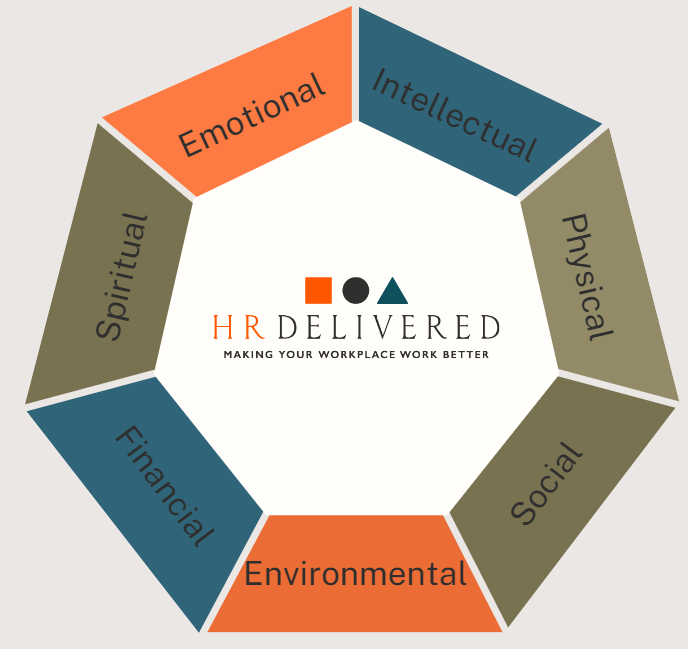In the hustle and bustle of running your highly successful SME, when your daily focus is profitability, resources, performance, and accountability, it’s so easy to lose sight of other aspects that matter: The wellbeing of your most important asset – your employees.
Why should this concern you?
Poor health among employees’ costs UK employers £42bn – £45bn each year! This is made up of absence costs of around £7bn, presenteeism costs ranging from about £27bn to £29bn and turnover costs of around £9bn (Deloitte (2020) Mental Health and employers).
How can you beat this battle?
Did you know that only 31% of UK workers feel that their employer cares about their wellbeing (CIPD)? Read on to find out how you can beat the battle and fully support the wellbeing of your employees, let us help you to fully understand employee wellbeing in its entirety…
Absence Rates vs Productivity: Approximately 1 in 6 people experience mental health problems in the workplace (Mind), this leads to high absence rates which has a direct impact on the productivity of your team(s). Introducing a Wellbeing Strategy will encourage a highly engaged workforce, thus increasing profitability by 21% (Gallup).
Ways to Wellbeing Wheel: Wellbeing is multidimensional, encompassing several key components. We, at HR Delivered like to define it in a wheel:

Let’s look at those segments in more detail:
- Emotional: This revolves around understanding and managing one’s own emotions, developing healthy coping mechanisms, practicing self-compassion, and cultivating a sense of optimism and gratitude. Mental wellbeing involves managing stress effectively, fostering a high level of resilience, maintaining positive relationships, and seeking support when needed.
- Intellectual: Having an effective career development program will lead to an enhanced workforce, everyone needs to know what career path they can follow in order to get to where they want to be. It’s also about cultivating a growth mindset and engaging in activities that stimulate their minds.
- Physical: This includes taking care of one’s body through regular exercise, balanced nutrition, adequate sleep, and preventive healthcare practices. Regular physical activity is crucial for maintaining cardiovascular health, muscle strength, flexibility, and overall fitness. Your employees should aim for a combination of aerobic exercises (e.g., walking, running, swimming) and strength training activities to promote physical wellbeing.
- Social: Generally, people are inherently social beings, and relationships play a crucial role in their overall wellbeing. Building and nurturing supportive connections with family, friends, and community members is vital for your employee’s social wellbeing. Strong social connections and supportive relationships are associated with better health outcomes.
- Environmental: This focuses on their relationship with their immediate surroundings and how it impacts their overall health and wellness. It involves creating a living environment that promotes physical health, mental clarity, and emotional balance. This includes factors such as maintaining a clean, safe, and organised work and living space.
- Financial: This encompasses one’s ability to effectively manage their finances in a way that supports their current and future financial goals. It involves having control over personal finances, including income, expenses, savings, investments, and debt management. Achieving financial security and stability allows your employees to feel empowered, it reduces financial stress, and provides them with the confidence to pursue their personal aspirations.
- Spiritual: This dimension involves finding their own personal meaning and purpose in life, connecting with something greater, whether it’s through their personal beliefs or values, nature, or art. Cultivating a sense of personal spirituality can provide a sense of peace, purpose, and direction.
How can you implement a Wellbeing Strategy?
Here at HR Delivered, we can help to implement your People/Wellbeing Strategy to improve wellbeing in the workplace, here are some simple steps:
- Employee Assistance Programmes (EAPs): You should implement an EAP to primarily support the overall well-being and productivity of your workforce. EAPs provide employees with confidential access to professional assistance for personal and work-related issues, including mental health concerns, substance abuse problems, financial stress, and relationship issues. By offering this support, issues can be addressed proactively, leading to improved employee morale, reduced absenteeism, and increased productivity. EAPs also demonstrate a commitment to employee welfare, which can enhance loyalty and retention. Moreover, by helping employees navigate challenges effectively, EAPs contribute to a healthier work environment and ultimately support the company’s bottom line by reducing turnover costs and promoting a more resilient workforce.
- Work-life balance policies: Allow your employees to balance work and personal life commitments by offering options like remote working, hybrid working, flexible hours, or compressed work-weeks. Your employees should be actively encouraged to learn to set boundaries to protect their time, energy, and emotional wellbeing. Saying “no” when necessary, delegating tasks, and prioritising activities that align with their personal values and goals can help prevent burnout and maintain balance in life. Balancing work, family, and personal commitments is essential for maintaining physical wellbeing.
- Re-charging the batteries: Three in five (60%) say they work longer hours than they want and one in four (24%) say they overwork by more than ten or more hours a week (CIPD). Therefore, it should be noted that taking time to recharge should not be a luxury; it’s a necessity for sustained success and personal happiness. Employees should learn to embrace the power of rest and rejuvenation. Ensure your workplace culture encourages regular breaks, provides hydration opportunities and facilities, after all, it’s fuel that ignites creativity and passion. Insist that employees take their holidays and rest days, you’ll find that employees will emerge stronger and more resilient. Your annual leave policy can re-enforce your wellbeing culture. Establish policies that encourages this, such as generous annual leave, parental leave, and policies to prevent burnout.
- Mental Health awareness training: Provide training sessions to raise awareness about mental health issues, reduce stigma, and equip managers with skills to support employees’ mental wellbeing. Consider professional training for several employees across the company, encourage them to implement a Care Plan for those who are vulnerable. Offer stress reduction techniques, yoga, mindfulness sessions, and access to resources like meditation apps or stress management workshops (these are sometimes linked to EAPs services or health cover benefits).
- Health benefits: The focus is on encouraging your employees to build healthy habits that support their physical wellbeing, such as exercising regularly, eating a balanced diet, staying hydrated, and getting sufficient rest. Small, consistent actions add up over time and can have a profound impact on their overall health and vitality. Help them to avoid unhealthy habits such as smoking, excessive alcohol consumption, and drug abuse, which can negatively impact physical health. Consider offering schemes to help them reduce these areas and promote the benefits of a healthy lifestyle. Provide comprehensive health insurance coverage, including mental health services, and access to wellness resources like gym memberships or wellness services.
- Enhancing brain function: Taking regular breaks from work is essential for maintaining productivity, reducing stress, and promoting overall wellbeing. Incorporating regular breaks in the work schedule is beneficial during the working day as productivity is enhanced, mental fatigue is reduced, stress can be avoided, creativity improves and physical activity can be achieved by allowing them time to move around and stretch, preventing discomfort from prolonged sitting or standing. Breaks should be used to hydrate and refuel their body by drinking water and eating nutritious snacks. Therefore, water fountains and fruit baskets are a simple and cost-effective method of promoting this approach.
- Financial planning: Financial stress and its knock-on effects for mental health are wellbeing and physical health are everyday challenges for your employees. Research shows that 24% of UK employees surveyed in 2022 reported worry about money on a daily basis (Wagestream, State of Financial Wellbeing, 2022). With finances being top of the agenda for the vast majority of your employees, with ever increasing energy bills and mortgage rates, it’s imperative to educate your workforce in how to handle their money.
- Recognition and appreciation: Implement programmes and award schemes to recognise and appreciate employees’ contributions, these really foster a positive work environment and boost morale. This should include recognition for long-service and loyalty. Ensure your workplace culture recognises the good work of others, allow for public appreciation, consider employee appreciation/nomination schemes. A well done from a colleague goes a long way to promoting wellbeing and job satisfaction.
- Career Development opportunities: Support employees’ growth and development through training, mentoring, and career advancement opportunities, enhancing their sense of purpose and satisfaction at work. Ensure your company cultivates a curious mindset and embraces opportunities for learning and personal growth. Whether it’s acquiring new skills, pursuing hobbies, or exploring different perspectives, continuous learning can enrich their life and enhance a sense of fulfilment. Lifelong learning refers to the ongoing process of acquiring knowledge, skills, and personal development throughout one’s life. It emphasises the importance of continuous education and growth beyond formal schooling or specific career goals. No-one is ever too old to learn!
- Nurturing relationships: To “nurture relationships” means to actively cultivate and strengthen connections with others, whether they are personal or professional. Facts show the different communication methods used once a week or more: 86% text or instant message, 82% speak on phone, 71% met up in person, 33% email or wrote (Department for Culture, Media & Sport). Therefore, time and effort in nurturing meaningful relationships with colleagues and loved ones should be actively encouraged. Your culture should ensure that employees carve ways for regular communication, express gratitude, and appreciation, and offer support to each other during both good times and bad. Strong social connections are a cornerstone of wellbeing.
- Open communication channels: Create avenues for employees to express concerns, provide feedback, and seek support from HR or management, fostering a culture of trust and support. Consider regular surveys, organisations can effectively leverage employee surveys to gather valuable insights, foster employee engagement, and drive positive change within the workplace, as well as ensuring employee engagement.
- Charity day(s): Offering a charity day is another excellent way for HR to support wellbeing. This initiative allows employees to take paid time off to engage in volunteering or charitable activities of their choice. Participating in charitable activities gives employees a sense of purpose and fulfilment, contributing positively to their mental and emotional wellbeing.
Implementation Success: Follow our 4 C’s approach to ensure effective implementation of your Wellbeing Strategy:
- Clear Action Plan
- Collaboration
- Communication
- Celebrate Achievements
Conclusion: In conclusion, prioritising wellbeing, either personally or implementing it as a Company-wide People/Wellbeing Strategy is essential for leading a fulfilling and engaged workforce. Overall, implementing a wellbeing approach within your Company will contribute to a positive workplace culture, enhance employee wellbeing, and strengthen the organisation’s relationship with its employees. This in turn, will lead to lower attrition, reduce absences and increase retention.
By taking our 7-step approach that addresses the various dimensions of wellbeing—physical, emotional, intellectual, social, environmental, financial, and spiritual—we can all cultivate greater resilience, vitality, and happiness. By incorporating practical strategies in your policies such as self-care, healthy habits, mindfulness, nurturing relationships, setting boundaries, lifelong learning, and gratitude into the daily lives of your employees, we can all nurture wellbeing and thrive in every aspect of life.
Remember, the wellbeing of your employees is not a destination but a journey—a long journey worth investing in for a happier, healthier, and more fulfilling workforce!



